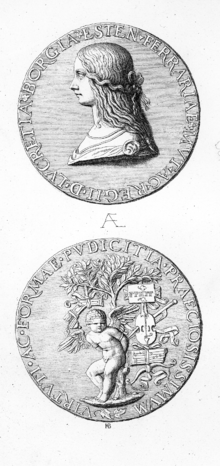Lucrezia Borgia
![]()
This article is about the person. For artistic adaptations of the same name, see Lucrezia Borgia (disambiguation).
Lucrezia Borgia [luˈkrɛtːsi̯a ˈbɔrdʒa] (Latin Lucretia Borgia; Spanish/cat. Lucrecia Borja; * 18 April 1480 in Rome or Subiaco; † 24 June 1519 in Belriguardo near Ferrara) was an Italian-Spanish Renaissance princess and the illegitimate daughter of Pope Alexander VI with his mistress Vanozza de' Cattanei. She was the sister of Cesare, Juan and Jofré Borgia.
Described by contemporaries as pretty and fun-loving, Lucrezia became the beneficiary, but above all the instrument, of her father's policies after the rise of her notorious family.
Alexander VI, who loved her dearly, gave her the reins of government in the Vatican several times during his absence. He married her off three times in politically motivated marriages to consolidate the Borgia power. Lucrezia's first marriage, to Giovanni Sforza, was dissolved when she lost her usefulness to the Borgia family; her second husband, Alfonso of Aragon (1481-1500), Duke of Bisceglie, was murdered, presumably on the orders of her brother Cesare. In her third marriage she finally married Alfonso d'Este, Duke of Ferrara, to whom she remained married until her death and had several children.
Lucrezia survived the death of her father and the fall of her brother Cesare and the Borgia family in Italy unscathed; she died, highly honored, as Duchess of Ferrara.
The Borgia family still embodies the greed for power and moral corruption of the Renaissance papacy like no other, and Lucrezia Borgia retained a reputation for centuries as a wicked poisoner, adulteress and incestuous with her father as well as her brother Cesare. These accusations originated in the rumors and slanders of her own time and were later echoed and amplified by famous authors such as Victor Hugo and Alexandre Dumas in their works. It is only modern historical research that views Lucrezia Borgia in a different light and rejects these charges.

Signature Lucrezia Borgia

Contemporary depiction of Lucrezia Borgia as Duchess of Ferrara, copper engraving of a medal after a wax model by Filippino Lippi.
Origin
Lucrezia Borgia was born on 18 April 1480, the third of four children of the Spanish cardinal and vice-chancellor of the Church, Rodrigo Borgia, later Pope Alexander VI, and his long-time Italian mistress Vanozza de' Cattanei. She was probably born in Subiaco, one of her father's fortresses outside Rome, because her father initially wanted to keep the existence of his illegitimate family secret out of consideration for his church career. Illegitimate children were common among clerics of the time, but were usually passed off as nephews and nieces. Rodrigo Borgia therefore caused a scandal after his election as pope when he openly confessed to his children, who thus became known throughout Europe. Especially Lucrezia and her brother Cesare gained a notorious reputation that lasts until today.

Rodrigo Borgia
Entrepreneurial activity
In northern Italy, Lucrezia acquired seemingly worthless marshland, had it drained with the help of drainage ditches and canals, and then used it as pasture or cultivation land for grain, beans, olives, flax, and wine. Within six years she bought up to 20,000 hectares of land in northern Italy and made great profits.
Questions and Answers
Q: Who was Lucrezia Borgia?
A: Lucrezia Borgia (18 April 1480 – 24 June 1519) was the daughter of Pope Alexander VI and his long-term mistress Vannozza dei Cattanei.
Q: What were the names of her brothers?
A: Her brothers included Cesare Borgia, Giovanni Borgia, and Gioffre Borgia.
Q: How is Lucrezia often portrayed in artworks, novels, and films?
A: Lucrezia is often cast as a femme fatale in artworks, novels, and films.
Q: Was she involved in the political activities of her father and brothers?
A: It is unclear if she was involved in the political activities of her father and brothers.
Q: How did they use her to further their own ambitions?
A: They arranged several marriages for her to important and powerful men which presumably helped their own political ambitions.
Q: Who were some of the people that she married?
A: She was married to Giovanni Sforza (Lord of Pesaro), Alfonso of Aragon (Duke of Bisceglie), and Alfonso I d'Este (Duke of Ferrara).
Q: What happened to Alfonso of Aragon after he lost his political value?
A: Tradition has it that Alfonso may have been murdered by Lucrezia's brother Cesare when his political value faded.
Search within the encyclopedia